
- Home
- Travel Packages
- Top Destination
-
Travel Attraction
By Category
Top Attraction

- Travel Agents
- Car Rentals
- Hotels
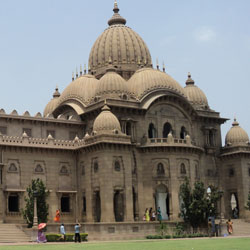
About The Belur Math Temple The Belur Math Temple, located in Belur near Kolkata, is a prominent place of worship and spiritual retreat for followers of the Ramakrishna Movement. The temple complex is a symbol of unity and harmony, bringing together people of different faiths and backgrounds under one roof. Architecture of Belur Math Temple The architecture of the Belur Math Temple is a blend of various styles, including Hindu, Islamic, and Christian influences. The main temple is built in the traditional Bengali style of architecture, with intricate carvings and sculptures that depict scenes from Hindu mythology. The temple's central dome is influenced by the Mughal style of architecture, while the surrounding buildings showcase a unique combination of European and Indian design elements. History The Belur Math Temple was established in 1899 by Swami Vivekananda, a disciple of the Indian saint Sri Ramakrishna. The temple was built as a tribute to Sri Ramakrishna and serves as the headquarters of the Ramakrishna Math and Ramakrishna Mission. Over the years, the temple has become a center of spiritual and cultural activities, attracting devotees and visitors from all over the world. Best Time To Visit The best time to visit the Belur Math Temple is during the annual celebrations of Sri Ramakrishna's birthday, which usually falls in February. During this time, the temple is adorned with lights and decorations, and special prayers and rituals are conducted to honor the saint's teachings. Visitors can witness the vibrant atmosphere and participate in the festivities that take place during this time. How To Reach The Belur Math Temple is easily accessible from Kolkata, which is located approximately 6 kilometers away. Visitors can take a taxi, bus, or train to reach the temple complex. The nearest railway station is Belur Math, which is well connected to Kolkata and other major cities in the region. From the railway station, it is a short walk to the temple complex. Significance Of The Belur Math Temple The Belur Math Temple holds great significance for followers of the Ramakrishna Movement and serves as a place of spiritual solace and enlightenment. The temple complex is not just a place of worship but also a center for social service, education, and cultural exchange. It stands as a symbol of unity and universal brotherhood, promoting the teachings of Sri Ramakrishna and Swami Vivekananda to the world. Overall, the Belur Math Temple is a place of great historical and cultural importance, attracting devotees and visitors alike with its beautiful architecture, serene surroundings, and profound spiritual atmosphere.
Explore More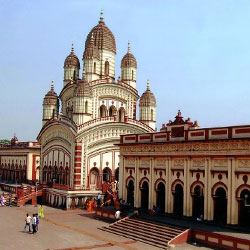
About The Kali Temple The Kali Temple, also known as Kalighat Kali Temple, is one of the most famous temples in Kolkata, India. It is dedicated to Goddess Kali, the Hindu goddess of time, creation, destruction, and power. The temple is located in the Kalighat area of Kolkata and is visited by thousands of devotees and tourists every year. Architecture of Kali Temple The Kali Temple's architecture is a unique blend of traditional Bengali style and modern design. The temple complex is spread over a large area and consists of a main temple building, several smaller shrines, a courtyard, and a pond. The main temple is adorned with intricate carvings and sculptures of Hindu gods and goddesses, and the central deity, Goddess Kali, is depicted in her fierce form, standing on Lord Shiva. History The history of the Kali Temple dates back to the 16th century when a small temple was built on the banks of the Adi Ganga river. Over the centuries, the temple was renovated and expanded several times, and the current structure was built in the early 19th century by the Sabarna Roy Choudhury family. The temple has since become a major pilgrimage site for devotees of Goddess Kali. Best Time To Visit The best time to visit the Kali Temple is during the festival of Kali Puja, which usually falls in October or November. The temple is beautifully decorated with lights, flowers, and colorful decorations during this time, and special prayers and rituals are performed to honor the goddess. Other auspicious times to visit the temple include Tuesdays and Saturdays, which are considered sacred days for worshipping Goddess Kali. How To Reach The Kali Temple is located in the Kalighat area of Kolkata, which is well-connected by road, rail, and air. The nearest railway station is Kalighat Metro Station, which is just a short walk away from the temple. The temple is also easily accessible by bus or taxi from any part of the city. For those coming from out of town, the Kolkata International Airport is the nearest airport, located about 20 kilometers away from the temple. Significance Of The Kali Temple The Kali Temple holds great significance for devotees of Goddess Kali, who believe that worshipping her can bring protection, prosperity, and spiritual fulfillment. The temple is also a popular tourist attraction, drawing visitors from all over the world who come to marvel at its stunning architecture and experience the vibrant culture and traditions of Kolkata. The Kali Temple is not just a place of worship but also a symbol of the rich heritage and deep-rooted spirituality of India. Overall, the Kali Temple in Kolkata is a must-visit destination for anyone seeking a spiritual experience or a glimpse into the colorful tapestry of Indian culture and tradition.
Explore More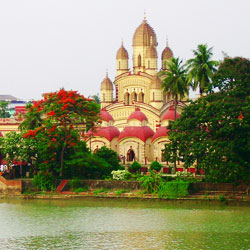
About The Dakshineswar Temple The Dakshineswar Temple is a famous Hindu temple located in Dakshineswar near Kolkata, West Bengal. It is dedicated to Goddess Kali and is known for its unique architecture and spiritual significance. The temple complex is situated on the eastern bank of the Hooghly River and is a popular pilgrimage site for devotees from all over India. Architecture of Dakshineswar Temple The Dakshineswar Temple was built in the traditional Bengali Navaratna style of architecture. The main temple is surrounded by 12 smaller shrines dedicated to different forms of the Goddess Kali. The temple complex also includes a large courtyard, a bathing ghat, and a temple dedicated to Lord Shiva. History The Dakshineswar Temple was built in 1855 by Rani Rashmoni, a wealthy philanthropist and devotee of Goddess Kali. The construction of the temple was supervised by Ramakrishna Paramahamsa, a renowned saint and spiritual leader. The temple gained fame due to the presence of Ramakrishna Paramahamsa, who attracted a large number of followers to the temple. Best Time To Visit The best time to visit the Dakshineswar Temple is during the annual festival of Kali Puja, which usually falls in October or November. The temple is beautifully decorated during this time, and special rituals and prayers are conducted in honor of the Goddess Kali. Visitors can witness cultural performances, processions, and other festivities during the festival. How To Reach The Dakshineswar Temple is easily accessible by road, rail, and waterways. It is located about 12 kilometers from Kolkata city center and can be reached by taxi, bus, or auto-rickshaw. The nearest railway station is Dakshineswar Railway Station, which is well-connected to Kolkata and other major cities in India. Visitors can also take a boat ride across the Hooghly River to reach the temple. Significance Of The Dakshineswar Temple The Dakshineswar Temple holds immense significance for devotees of Goddess Kali. It is believed that worshipping at the temple can help devotees overcome obstacles, attain spiritual liberation, and seek the blessings of the Divine Mother. The temple is also associated with the teachings of Ramakrishna Paramahamsa, who preached the message of universal love and harmony. In conclusion, the Dakshineswar Temple is not just a place of worship but a symbol of spiritual heritage and cultural richness. It continues to attract visitors and devotees from all walks of life, seeking solace, guidance, and blessings from the Divine. Whether you are a religious pilgrim or a curious traveler, a visit to the Dakshineswar Temple is sure to leave you in awe of its beauty and serenity.
Explore More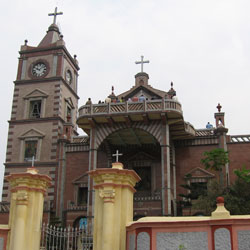
About Bandel, Kolkata Bandel is a small town located in the Hooghly district of West Bengal, India. It is most well-known for the Bandel Church, a historic church that dates back to the 17th century and is a popular pilgrimage site for Christians in the region. The town is also home to a vibrant community and has a rich cultural heritage that is evident in its architecture, cuisine, and traditions. Visiting Hours The Bandel Church is open to visitors from 6:00 AM to 6:00 PM every day of the week. However, it is best to check the specific timings before planning your visit to ensure that the church is open to the public. History The Bandel Church, also known as the Basilica of Our Lady of the Rosary, was established by the Portuguese in 1599. It is one of the oldest Christian churches in West Bengal and is a significant historical and religious landmark in the region. Church Services and Events The church holds regular services for worshippers, including daily Mass and special services on Sundays and religious holidays. Additionally, the church hosts various events throughout the year, such as festivals, processions, and feasts in honor of saints. For specific timings of church services and events, it is recommended to contact the church directly or check their official website for the latest information. Architectural Facts The Bandel Church is a fine example of Portuguese architecture, featuring a unique combination of European and Indian design elements. The church's facade is adorned with intricate carvings, statues, and frescoes that depict scenes from the Bible and Christian iconography. The church's interior is equally impressive, with ornate altars, marble columns, and stained glass windows that create a serene and peaceful atmosphere for worshippers and visitors alike. Accessibility and Directions Bandel is easily accessible by both car and public transport. If traveling by car, the town is well-connected to major highways and roads, making it easy to reach from nearby cities like Kolkata and Howrah. For those using public transport, Bandel has a railway station and bus stops that are serviced by regular trains and buses from Kolkata and other nearby towns. Additionally, there are plenty of taxis and auto-rickshaws available for hire in the town. There is ample parking available near the Bandel Church for those driving to the site. The church is also wheelchair accessible, with ramps and facilities for visitors with mobility challenges. Visitor's Information There is no entry fee to visit the Bandel Church, but donations are appreciated to help maintain the historic site. Guides are available for hire for those interested in learning more about the church's history and significance. After visiting the church, visitors can explore nearby attractions such as the Hooghly River, Dutch Cemetery, and Imambara. It is recommended to dress modestly when visiting the church out of respect for its religious significance.
Explore More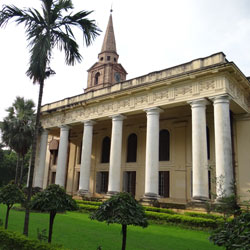
About St. John's Church, Kolkata Location and Visiting Hours St. John's Church, located in Kolkata, India, is open to visitors from Monday to Saturday from 9:00 AM to 12:00 PM and from 3:00 PM to 6:00 PM. On Sundays, the church is open from 9:00 AM to 12:00 PM for worship services. History St. John's Church, built in 1787, is one of the oldest churches in Kolkata. It was constructed during the British colonial period and served as a place of worship for the British residents of the city. The church has a rich history and has witnessed many important events over the years. Church Services and Events The church holds regular worship services on Sundays and special events or festivals throughout the year. The timings for these services and events can vary, so it is recommended to check the church's website or contact them directly for more information. Weddings at St. John's Church St. John's Church is open for weddings, and couples interested in having their ceremony at the church can inquire about availability and booking procedures. The church provides a beautiful and historic setting for wedding ceremonies. Architectural Facts St. John's Church is known for its stunning architecture, which reflects a blend of neoclassical and Gothic styles. The church features a towering spire, intricate stained glass windows, and ornate sculptures. The interior of the church is equally impressive, with high ceilings, elegant columns, and intricate woodwork. Accessibility and Directions St. John's Church is easily accessible by car or public transport. The church is located in the heart of Kolkata, making it convenient for visitors to reach. Parking is available near the church for those arriving by car, and the church is wheelchair accessible for individuals with mobility challenges. Visitor's Information There is no entry fee to visit St. John's Church, and guided tours may be available for those interested in learning more about the church's history and architecture. Nearby attractions to visit around the church include the Victoria Memorial, the Indian Museum, and the Maidan. There is no specific dress code for visitors, but it is recommended to dress modestly out of respect for the church as a place of worship.
Explore More
About St Paul's Cathedral Kolkata St Paul's Cathedral, located in Kolkata, India, is a historic Anglican cathedral that is known for its magnificent architecture and rich history. The cathedral is considered to be one of the finest examples of Indo-Gothic architecture in the country and attracts visitors from all over the world. Location and Visiting Hours St Paul's Cathedral is located at 1A, Cathedral Road, Kolkata, and is open to visitors from Monday to Saturday from 9:00 am to 12:00 pm and 3:00 pm to 6:00 pm. On Sundays, the cathedral is open from 7:00 am to 6:00 pm for church services and visitors. History The foundation stone of St Paul's Cathedral was laid in 1839, and the cathedral was consecrated in 1847. It was designed by William Nairn Forbes in a Gothic Revival style and is considered to be one of the most important buildings in Kolkata's architectural heritage. Church Services and Events The cathedral holds regular church services on Sundays, as well as special events and festivals throughout the year. The timings for the church services vary, so it is recommended to check the cathedral's website for the most up-to-date information. Weddings St Paul's Cathedral is a popular venue for weddings, and couples can inquire about scheduling their wedding ceremony at the cathedral through the church office. Architectural Facts St Paul's Cathedral features a stunning façade with intricate carvings and a tall spire that dominates the Kolkata skyline. The interior of the cathedral is equally impressive, with beautiful stained glass windows, vaulted ceilings, and ornate decorations that reflect the cathedral's rich history and heritage. Accessibility and Directions St Paul's Cathedral is easily accessible by car or public transport. The cathedral is located in the heart of Kolkata and can be reached by taxi, bus, or metro. Parking is available near the cathedral for visitors who are driving. The cathedral is also wheelchair accessible, with ramps and elevators available for those with mobility issues. Visitor's Information There is no entry fee to visit St Paul's Cathedral, but donations are welcome to help maintain the historic building. Guides are available to provide tours of the cathedral and share its history with visitors. Nearby attractions to visit around St Paul's Cathedral include Victoria Memorial, Maidan, and Park Street, where visitors can explore more of Kolkata's rich cultural heritage. There is no specific dress code for visitors, but modest attire is recommended when visiting the cathedral.
Explore More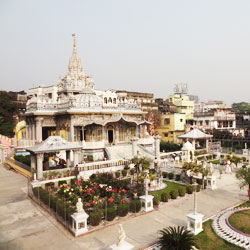
About Pareshnath Jain Temple, Kolkata The Pareshnath Jain Temple is a popular religious site located in the city of Kolkata, West Bengal. It is dedicated to the Jain community and is known for its intricate architecture and serene ambiance. The temple attracts devotees and tourists alike from all over the country who come to seek blessings and marvel at the beauty of the temple. History The Pareshnath Jain Temple was built in the late 19th century by a group of Jain merchants who settled in Kolkata. The temple was dedicated to the 10th Jain Tirthankara, Shri Sital Nath Ji. Over the years, the temple has undergone several renovations and expansions, but its original charm and spiritual significance have remained intact. Architecture and Design The Pareshnath Jain Temple features a blend of traditional Jain architecture with modern design elements. The temple is adorned with intricate carvings, colorful murals, and marble statues. The main sanctum sanctorum houses the idol of Lord Sital Nath Ji, and the entire temple complex exudes a sense of peace and tranquility. Best Time to Visit Visiting the Pareshnath Jain Temple is ideal during the winter months (October to March) when the weather is pleasant and conducive for exploring the temple premises. The temple is open throughout the year, but it is advisable to avoid visiting during monsoon season due to heavy rainfall. Cultural Significance The Pareshnath Jain Temple holds great cultural significance for the Jain community in Kolkata. It is a place of worship, meditation, and spiritual learning for followers of Jainism. The temple also serves as a venue for religious festivals, rituals, and community gatherings. Pilgrimage Practices Devotees visiting the Pareshnath Jain Temple often engage in traditional practices such as offering prayers, performing rituals, and seeking blessings from the deity. Pilgrims may also participate in religious discourses, bhajans, and meditation sessions conducted at the temple premises. Dress Code and Etiquette Visitors to the Pareshnath Jain Temple are required to dress modestly and remove their footwear before entering the temple premises. Additionally, it is important to maintain silence and respect the sanctity of the temple. Photography and videography may be restricted in certain areas of the temple. Activities and Experiences Some of the activities and experiences that visitors can enjoy at the Pareshnath Jain Temple include attending religious ceremonies, exploring the temple complex, and interacting with the resident priests. The temple also hosts cultural programs, lectures, and workshops on Jain philosophy and spirituality. Art and Religious Symbols The Pareshnath Jain Temple is known for its exquisite artistry and religious symbolism. The temple walls are adorned with intricate paintings depicting scenes from Jain mythology and teachings. Symbolic representations of Jain deities, Tirthankaras, and sacred symbols can be found throughout the temple. Local Insights For a deeper understanding of the history and significance of the Pareshnath Jain Temple, visitors can interact with the local Jain community members and temple authorities. They can provide insights into the customs, traditions, and practices followed at the temple, as well as offer guidance on exploring the spiritual aspects of Jainism.
Explore More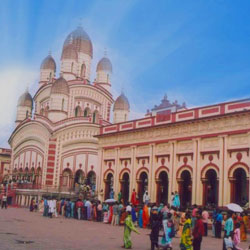
About The Kalighat Temple The Kalighat Temple, located in Kolkata, West Bengal, is one of the most well-known and revered temples in India. Dedicated to the Hindu goddess Kali, the temple attracts devotees from all over the country. The temple holds great significance in Hindu mythology and is considered a sacred place for worship. Architecture of Kalighat Temple The Kalighat Temple is a beautiful example of traditional Bengali temple architecture. The temple complex consists of a main shrine dedicated to Goddess Kali, surrounded by smaller shrines dedicated to various other deities. The temple is adorned with intricate carvings and sculptures, depicting scenes from Hindu mythology. The main sanctum of the temple houses a black stone idol of Goddess Kali, adorned with garlands of flowers and other offerings. The temple also features a large courtyard where devotees can offer prayers and participate in religious ceremonies. History The history of the Kalighat Temple dates back to ancient times. According to legend, the temple was originally a small hut built by a sage named Brahmananda. The sage discovered a hidden image of Goddess Kali in the jungle and decided to build a shrine in her honor. Over the years, the temple gained popularity and underwent several renovations and expansions. It became a center of pilgrimage for devotees seeking blessings from the powerful goddess. The temple has survived various natural calamities and invasions, standing as a symbol of resilience and faith. Best Time To Visit The best time to visit the Kalighat Temple is during the Navratri festival, which falls in the months of September or October. During this time, the temple is adorned with lights and decorations, and special ceremonies are held to honor the goddess. It is also recommended to visit the temple early in the morning or late in the evening to avoid the crowds and experience the peaceful atmosphere of the temple. The temple is open to visitors throughout the year, but it is best to check the temple timings before planning your visit. How To Reach The Kalighat Temple is easily accessible by various modes of transportation. The nearest railway station to the temple is Kalighat Metro Station, which is well connected to the rest of the city. Visitors can also take a taxi or a bus to reach the temple from any part of Kolkata. If you are traveling from outside the city, Netaji Subhas Chandra Bose International Airport is the nearest airport to the temple. From the airport, you can hire a taxi or take a bus to reach the temple conveniently. Significance Of The Kalighat Temple The Kalighat Temple holds immense significance in Hindu mythology and is believed to be one of the 51 Shakti Peethas, where different parts of the goddess Sati's body fell. The temple is considered a powerful place of worship, where devotees seek blessings for protection, prosperity, and well-being. Devotees visit the temple to offer prayers, perform rituals, and seek guidance from the goddess. The temple is also a popular destination for tourists interested in exploring the rich cultural and religious heritage of India. In conclusion, the Kalighat Temple in Kolkata is a sacred place that holds great spiritual and cultural significance. The temple's rich history, beautiful architecture, and peaceful ambiance make it a must-visit destination for anyone traveling to Kolkata. Plan your visit to the Kalighat Temple to experience the divine presence of Goddess Kali and seek her blessings for a prosperous life.
Explore More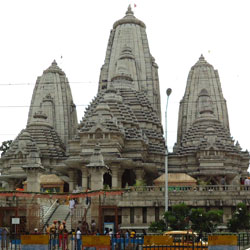
About The Birla Mandir Temple The Birla Mandir Temple, also known as the Lakshmi-Narayan Temple, is a beautiful Hindu temple located in Kolkata, West Bengal. It was built by the renowned industrialist Birla family in 1970 and is dedicated to Lord Vishnu (Narayan) and Goddess Lakshmi. The temple is famous for its stunning architecture, intricate carvings, and serene ambiance, making it a popular attraction for locals and tourists alike. Architecture of Birla Mandir Temple The Birla Mandir Temple is a fine example of traditional Indian temple architecture with a modern touch. The temple is made entirely of white marble, which reflects the sunlight and gives it a radiant glow. The main shrine houses beautifully sculpted idols of Lord Vishnu and Goddess Lakshmi, along with other deities. The intricate carvings on the walls and ceilings depict scenes from Hindu mythology, adding to the temple's grandeur. One of the highlights of the temple is the tall spire, or shikhara, that rises above the main sanctum sanctorum. The shikhara is adorned with intricate carvings and sculptures of various gods and goddesses, making it a sight to behold. The temple also features a large courtyard, where devotees can sit and meditate in peace, away from the hustle and bustle of the city. History The Birla Mandir Temple was commissioned by the Birla family, who were prominent industrialists and philanthropists in India. The construction of the temple began in 1970 and was completed in a short span of time. The Birla family wanted to create a place of worship that would be open to people of all castes and creeds, promoting unity and harmony among different communities. Since its inauguration, the Birla Mandir Temple has become a symbol of spirituality and peace in Kolkata, attracting thousands of devotees and tourists every year. The temple continues to be maintained and managed by the Birla family, who ensure that it remains a sacred and serene place for all who visit. Best Time To Visit The Birla Mandir Temple is open to visitors throughout the year, but the best time to visit is during the festivals of Diwali and Janmashtami. These festivals are celebrated with great fervor at the temple, with elaborate decorations and special prayers being offered to the deities. Visiting the temple during these festivals gives visitors a chance to experience the vibrant atmosphere and witness the rich traditions of Hindu culture. The temple is also less crowded during weekdays, making it a peaceful retreat for those seeking solace and spiritual rejuvenation. How To Reach The Birla Mandir Temple is located in the heart of Kolkata, making it easily accessible from all parts of the city. The nearest railway station is Howrah Junction, which is well connected to major cities across India. Visitors can also take a taxi or auto-rickshaw from any part of Kolkata to reach the temple. For those traveling by air, the Netaji Subhas Chandra Bose International Airport is the closest airport to the temple, with regular flights to and from major cities in India and abroad. Once at the airport, visitors can hire a taxi or take a bus to reach the temple in a convenient and hassle-free manner. Significance Of The Birla Mandir Temple The Birla Mandir Temple holds great significance for the people of Kolkata and devotees of Lord Vishnu and Goddess Lakshmi. It is not just a place of worship, but also a symbol of spirituality, unity, and peace. The temple's serene ambiance and beautiful architecture make it a popular destination for those seeking spiritual solace and inner peace. Visitors to the temple can offer prayers, meditate, or simply admire the beauty of the surroundings. The temple also hosts various cultural and religious events throughout the year, further enriching the spiritual experience of its visitors. Whether you are a devotee or a tourist, a visit to the Birla Mandir Temple is sure to leave you feeling uplifted and inspired.
Explore More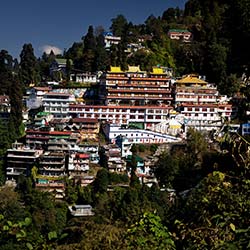
About Dali Monastery The Dali Monastery, located in Darjeeling, is a prominent Tibetan Buddhist monastery known for its stunning architecture and serene surroundings. It was built in the early 1970s and serves as a place of worship, learning, and meditation for the local Buddhist community. The monastery is dedicated to the Dali Lama, the spiritual leader of Tibetan Buddhism, and is a must-visit destination for those seeking spiritual enlightenment and inner peace. History, Architecture, and Design The Dali Monastery is a beautiful example of traditional Tibetan architecture, with its colorful prayer flags, intricate wood carvings, and golden roof. The monastery's design reflects the rich cultural heritage of Tibetan Buddhism, with its ornate temples, prayer halls, and meditation rooms. Visitors can admire the stunning frescoes, statues, and thangka paintings that adorn the monastery's walls, depicting various Buddhist deities and symbols. The monastery's peaceful atmosphere and breathtaking views of the surrounding mountains make it a truly special place to visit. Best Time to Visit The best time to visit the Dali Monastery is during the spring and autumn months, when the weather is mild and the skies are clear. This is the perfect time to explore the monastery's grounds, participate in meditation sessions, and witness traditional Buddhist ceremonies. Additionally, the annual Dali Lama's birthday celebration, held in July, is a major event at the monastery and a great opportunity to experience the local culture and traditions. Cultural Significance The Dali Monastery holds great cultural significance for the Tibetan Buddhist community in Darjeeling. It serves as a vital center for religious teachings, rituals, and ceremonies, and plays a key role in preserving and promoting Tibetan Buddhist culture and traditions. The monastery's monks are highly respected for their knowledge, wisdom, and compassion, and are revered by the local community for their dedication to spiritual practice and service to others. Pilgrimage Practices Visitors to the Dali Monastery can participate in various pilgrimage practices, such as circumambulating the monastery's prayer wheels, offering prayers and offerings at the shrines, and receiving blessings from the resident monks. Pilgrims are encouraged to cultivate mindfulness, compassion, and gratitude during their visit, and to reflect on the teachings of the Buddha as they explore the monastery's sacred spaces. Dress Code and Etiquette Visitors to the Dali Monastery are expected to dress modestly and respectfully, covering their shoulders and knees and removing their shoes before entering the temple grounds. It is important to observe silence and mindfulness while on the monastery's premises, and to show reverence and humility towards the resident monks and other worshippers. Photography is allowed in certain areas of the monastery, but it is important to ask for permission before taking photos of the monks or sacred objects. Activities and Experiences Visitors to the Dali Monastery can participate in a variety of activities and experiences, such as attending meditation sessions, participating in chanting ceremonies, and receiving teachings from the resident monks. The monastery also offers classes in Tibetan Buddhism, meditation, and traditional arts and crafts, providing visitors with a unique opportunity to deepen their spiritual practice and expand their cultural knowledge. Art and Religious Symbols The Dali Monastery is adorned with a wealth of beautiful art and religious symbols, including thangka paintings, mandalas, and statues of Buddha and various deities. These artistic creations serve as powerful teaching tools, conveying the wisdom and compassion of the Buddha and inspiring devotion and contemplation in the hearts of the faithful. Visitors can learn about the symbolism and significance of these sacred artworks by participating in guided tours and workshops offered at the monastery. Local Insights Exploring the Dali Monastery with a local guide can provide valuable insights into the history, culture, and spiritual practices of the Tibetan Buddhist community in Darjeeling. Local guides can offer a deeper understanding of the monastery's architecture, art, and rituals, as well as share personal anecdotes and stories about their own experiences at the monastery. Engaging with the local community through interactions with monks, pilgrims, and artisans can also enrich visitors' understanding of Tibetan Buddhist culture and strengthen their connection to the spiritual essence of the Dali Monastery.
Explore More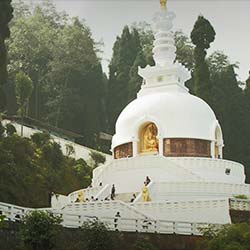
About Peace Pagoda, Darjeeling History The Peace Pagoda in Darjeeling was built under the guidance of Nichidatsu Fujii, a Japanese Buddhist monk, as a symbol of peace and harmony. It was inaugurated in 1992 by the Dalai Lama. The pagoda serves as a testament to the enduring friendship between India and Japan. Architecture and Design The Peace Pagoda follows traditional Japanese architectural style with its white dome and golden spire. The structure is adorned with intricate carvings and statues of Buddha, depicting various stages of his life. The pagoda stands tall amidst lush greenery, offering a serene and tranquil atmosphere to visitors. Best Time to Visit The best time to visit the Peace Pagoda in Darjeeling is during the months of March to May and September to November when the weather is pleasant and favorable for sightseeing. Avoid visiting during the monsoon season as heavy rainfall may disrupt your plans. Cultural Significance The Peace Pagoda is a symbol of peace, unity, and universal brotherhood. It serves as a place for people of all backgrounds to come together in prayer and meditation, promoting harmony and understanding among different cultures and communities. Pilgrimage Practices Visitors to the Peace Pagoda can engage in traditional Buddhist practices such as offering prayers, lighting incense sticks, and spinning prayer wheels for good luck and blessings. It is important to maintain silence and respect the religious customs observed by the monks and devotees. Dress Code and Etiquette While visiting the Peace Pagoda, it is advisable to dress modestly and conservatively out of respect for the sacredness of the place. Remove your shoes before entering the pagoda and maintain a quiet demeanor to not disturb the peaceful ambiance. Activities and Experiences At the Peace Pagoda, visitors can participate in meditation sessions, yoga classes, and spiritual talks conducted by the resident monks. You can also enjoy panoramic views of the surrounding mountains and valleys, making it a perfect spot for photography and introspection. Art and Religious Symbols The Peace Pagoda is adorned with intricate paintings, sculptures, and religious symbols that reflect the teachings and philosophies of Buddhism. The statues of Buddha and other deities serve as objects of reverence and inspiration for those seeking spiritual enlightenment. Local Insights The local community in Darjeeling holds the Peace Pagoda in high regard, considering it a sacred place of worship and contemplation. They actively participate in the upkeep and maintenance of the pagoda, ensuring that it remains a beacon of peace and harmony for generations to come.
Explore More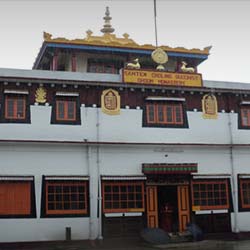
About Ghum Monastery Ghum Monastery, also known as Yiga Choeling Monastery, is a prominent Buddhist monastery located in Ghum, Darjeeling. It is one of the oldest Tibetan Buddhist monasteries in the region and holds great cultural and spiritual significance. The monastery is known for its stunning architecture and rich history, making it a popular tourist attraction in Darjeeling. History, Architecture and Design Ghum Monastery was established in 1850 by Lama Sherab Gyatso, a monk from Tibet. The monastery's architecture reflects traditional Tibetan design, with intricate paintings, sculptures, and prayer wheels adorning its walls. The main attraction of the monastery is a 15-foot high statue of Maitreya Buddha, believed to be one of the largest of its kind in the region. Best Time to Visit The best time to visit Ghum Monastery is during the months of March to May and September to November when the weather is pleasant and ideal for sightseeing. Avoid visiting during the monsoon season as heavy rainfall can disrupt your travel plans. Cultural Significance Ghum Monastery holds immense cultural significance for the Tibetan community in Darjeeling. It serves as a center for Buddhist teachings, meditation, and spiritual practices. The monastery also hosts various cultural events and festivals throughout the year, attracting devotees and tourists alike. Pilgrimage Practices Visitors to Ghum Monastery are encouraged to participate in the daily rituals and practices observed by the resident monks. This includes attending morning prayers, meditation sessions, and offerings to the Buddha. Pilgrims can also seek blessings from the monks and receive spiritual guidance during their visit. Dress Code and Etiquette When visiting Ghum Monastery, it is important to dress modestly and respectfully. Both men and women should wear clothing that covers their shoulders and knees out of respect for the Buddhist traditions. It is also customary to remove your shoes before entering the monastery and to maintain a quiet and respectful demeanor during your visit. Activities and Experiences Visitors to Ghum Monastery can partake in various activities and experiences, including guided tours of the monastery, attending meditation classes, and participating in cultural workshops. You can also explore the surrounding area on foot, taking in the serene beauty of the Himalayan landscape and interacting with the local community. Art and Religious Symbols The interior of Ghum Monastery is adorned with exquisite paintings, murals, and religious symbols that tell the story of Tibetan Buddhism. The intricate artwork and sculptures depict scenes from Buddhist mythology and teachings, creating a peaceful and meditative atmosphere for visitors. Local Insights For a deeper understanding of Ghum Monastery and its significance, consider engaging with the local community and monks. They can provide insights into the monastery's history, daily practices, and cultural traditions, giving you a unique perspective on Tibetan Buddhism and the spiritual life of the region.
Explore MoreDarjeeling - Pelling - Ravangla - Namchi 6 Days 5 Nights Tour
6 Days/ 5 Night
Ravangla - Darjeeling - Pelling - Namchi
5 Night - 6 Days Sikkim Tour Package For - 4 Pax
6 Days/ 5 Night
Gangtok - Darjeeling
6 Night - 7 Days Sikkim Tour Package For - 5 Pax
7 Days/ 6 Night
Gangtok - Darjeeling - Namchi - Pelling
Sundarban 3 Days - 2 Nights Tour Package
3 Days/ 2 Night
Kolkata - South 24 Parganas
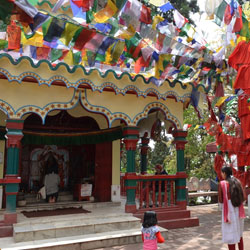
About The Mahakal Temple Located in Darjeeling, West Bengal, the Mahakal Temple is a popular Hindu temple dedicated to Lord Shiva. Situated at an altitude of 8,146 feet, the temple offers a breathtaking view of the snow-capped mountains and lush green surroundings. The temple holds great religious significance and is visited by devotees from all over the country. Architecture of Mahakal Temple The Mahakal Temple boasts traditional Indian architecture with intricate designs and beautiful sculptures. The temple is adorned with colorful paintings and carvings that depict mythological stories. The main sanctum sanctorum houses the idol of Lord Shiva in the form of Mahakal, which is worshipped by the devotees with great reverence. History The history of the Mahakal Temple dates back to the late 18th century when it was built by Lama Dorje Rinzing, a Buddhist monk. The temple was initially constructed as a meditation center for the Buddhist monks, but later it was transformed into a Hindu temple dedicated to Lord Shiva. Over the years, the temple underwent several renovations and expansions, making it the magnificent structure that it is today. Best Time To Visit The best time to visit the Mahakal Temple is during the months of March to May and September to November when the weather is pleasant and the views are clear. It is advisable to avoid visiting the temple during the monsoon season as the region experiences heavy rainfall, which can make the journey difficult. How To Reach The Mahakal Temple is easily accessible by road from Darjeeling town. Visitors can hire a taxi or take a shared jeep to reach the temple, which is located around 3 kilometers away from the main town. The journey to the temple is scenic and offers stunning views of the surrounding mountains and valleys. Significance Of The Mahakal Temple The Mahakal Temple holds great religious significance for the devotees, who believe that worshipping Lord Shiva at this sacred place can fulfill their wishes and bring prosperity in their lives. The temple also serves as a center for spiritual enlightenment and meditation, attracting seekers and devotees who seek solace and peace in the serene surroundings of the temple. In conclusion, the Mahakal Temple in Darjeeling is a divine abode of Lord Shiva that attracts devotees and tourists alike with its stunning architecture, rich history, and spiritual significance. Visiting this holy place is not just a religious experience but also an opportunity to connect with nature and find inner peace in the lap of the Himalayas.
Explore More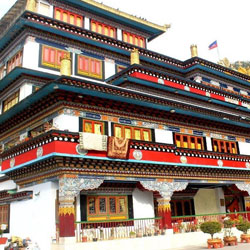
About the Buddhist Monastery, Darjeeling History The Buddhist Monastery in Darjeeling, also known as the Yiga Choeling Monastery, was established in 1850 by Lama Dorje Rinzing. It is one of the oldest monasteries in the region and holds significant historical importance in the development of Buddhism in Darjeeling. Architecture and Design The monastery features traditional Tibetan architecture, with colorful prayer flags adorning the exterior. The main prayer hall is adorned with intricate paintings and sculptures depicting Buddhist deities and symbols. The design of the monastery reflects the rich cultural heritage of the Tibetan Buddhist tradition. Best Time to Visit The best time to visit the Buddhist Monastery in Darjeeling is during the months of September to December when the weather is pleasant and clear, offering stunning views of the surrounding Himalayan mountains. It is also a great time to witness local festivals and religious ceremonies at the monastery. Cultural Significance The monastery plays a vital role in preserving and promoting Tibetan Buddhist culture and traditions in Darjeeling. It serves as a spiritual center for the local community and attracts pilgrims and visitors from around the world who seek spiritual guidance and enlightenment. Pilgrimage Practices Pilgrims visiting the monastery often engage in traditional Buddhist practices such as offering prayers, lighting butter lamps, and spinning prayer wheels. These practices are believed to accumulate merit and bring blessings to the devotees. Dress Code and Etiquette Visitors are advised to dress modestly and remove their shoes before entering the monastery. It is important to show respect for the monks and the sacred artifacts within the monastery by maintaining a quiet and peaceful demeanor during your visit. Activities and Experiences Visitors can participate in meditation sessions, attend teachings by Buddhist monks, and explore the monastery's library and museum. Taking part in these activities allows visitors to deepen their understanding of Tibetan Buddhist philosophy and practices. Art and Religious Symbols The monastery is adorned with vibrant thangka paintings, intricate mandalas, and statues of Buddha and other deities. These artistic expressions serve as visual representations of Buddhist teachings and help inspire devotion and contemplation among the worshippers. Local Insights Local residents often visit the monastery to seek blessings for prosperity and well-being. They participate in religious rituals and offer prayers for the well-being of their families and communities. The monastery serves as a spiritual sanctuary for the local population and a place of solace amidst the hustle and bustle of daily life in Darjeeling.
Explore More
About Ghoom Monastery The Ghoom Monastery, also known as the Yiga Choeling Monastery, is a renowned Buddhist monastery located in the town of Ghoom near Darjeeling, West Bengal, India. It was established in 1850 by Lama Sherab Gyatso and belongs to the Gelug school of Tibetan Buddhism. The monastery is famous for its impressive architecture and serene surroundings, attracting tourists and pilgrims from all over the world. History, Architecture, and Design The Ghoom Monastery has a rich history dating back to the mid-19th century. The monastery's architecture showcases traditional Tibetan design elements, with colorful frescoes, intricate wood carvings, and ornate statues adorning its interiors. The main highlight of the monastery is the 15-foot tall statue of Maitreya Buddha, believed to be one of the largest of its kind in the region. Best Time to Visit The best time to visit the Ghoom Monastery is during the months of October to December when the weather is pleasant and the monastery hosts various religious festivals and ceremonies. The early morning hours are ideal for witnessing the monks' prayer rituals and soaking in the peaceful ambiance of the monastery. Cultural Significance The Ghoom Monastery holds great cultural significance as a center of Buddhist learning and practice. It serves as a spiritual retreat for monks and visitors seeking tranquility and enlightenment. The monastery's teachings and rituals reflect the essence of Tibetan Buddhism, promoting peace, compassion, and mindfulness. Pilgrimage Practices Pilgrims visiting the Ghoom Monastery engage in traditional Buddhist practices such as prostrations, chanting mantras, and offering prayers to the Buddha. They seek blessings from the resident lamas and participate in meditation sessions to deepen their spiritual connection and inner peace. Dress Code and Etiquette Visitors to the Ghoom Monastery are expected to dress modestly and respectfully, covering their shoulders and legs. Shoes must be removed before entering the prayer halls, and photography is usually not allowed inside the monastery to maintain the sanctity of the religious space. Silence and mindfulness are encouraged to uphold the serene atmosphere of the monastery. Activities and Experiences Visitors to the Ghoom Monastery can participate in guided tours, meditation sessions, and cultural programs organized by the resident monks. They can explore the monastery's library, art collection, and gift shop to learn more about Tibetan Buddhism and purchase souvenirs. Trekking and nature walks in the surrounding Himalayan landscapes are also popular activities for tourists. Art and Religious Symbols The Ghoom Monastery is adorned with intricate Buddhist art and religious symbols that convey profound spiritual meanings. The colorful thangka paintings, symbolic mandalas, and sacred statues depict the life of the Buddha, the Wheel of Dharma, and other revered deities in Tibetan Buddhism. These artistic creations serve as visual aids for meditation and contemplation. Local Insights Local residents near the Ghoom Monastery are predominantly Tibetan and Nepali, practicing a blend of Buddhist and Hindu traditions. They warmly welcome visitors and offer insights into their cultural heritage, cuisine, and lifestyle. Exploring the nearby markets and tea gardens allows tourists to experience the vibrant local community and savor authentic flavors of Darjeeling. In conclusion, the Ghoom Monastery in Darjeeling stands as a spiritual sanctuary and cultural gem that invites travelers to immerse themselves in the wisdom and tranquility of Tibetan Buddhism. Its historical roots, architectural beauty, and religious practices make it a must-visit destination for those seeking spiritual enlightenment and cultural enrichment.
Explore More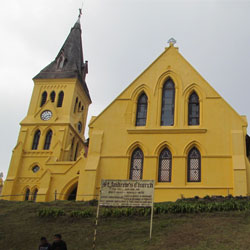
About St. Andrews Church Located in the picturesque hill town of Darjeeling, St. Andrews Church is a famous landmark known for its stunning architecture and historical significance. The church is situated in the heart of the town, offering breathtaking views of the surrounding mountains and valleys. Visiting Hours St. Andrews Church is open to visitors from 9:00 AM to 5:00 PM every day of the week. Visitors are welcome to explore the church and its surroundings during these hours. History St. Andrews Church was built in 1843 by the British during the colonial era. It has stood as a symbol of Christianity in Darjeeling for over a century, attracting visitors from all over the world. Church Services and Events The church holds regular services on Sundays at 10:00 AM and special events or festivals are organized throughout the year. Visitors can check the church's schedule for timings of these events. Weddings at St. Andrews Church St. Andrews Church is open for weddings and offers a beautiful and serene setting for couples looking to tie the knot. Interested couples can contact the church for more information on booking their wedding at this historic venue. Architectural Facts St. Andrews Church is a prime example of colonial architecture with its Gothic-style design, stained glass windows, and towering spires. The church's interior is adorned with intricate woodwork and beautiful murals, adding to its charm and allure. Accessibility and Directions St. Andrews Church is easily accessible by car or public transport. Visitors can also opt for a scenic walk to the church from the town center. Parking is available near the church, and the venue is wheelchair accessible. Visitor's Information There is no entry fee to visit St. Andrews Church, and guides are available on-site to provide visitors with more information about the church's history and significance. Nearby attractions include the Darjeeling Himalayan Railway and the scenic Tiger Hill. There is no specific dress code to enter the church, but visitors are advised to dress modestly out of respect for the religious site.
Explore More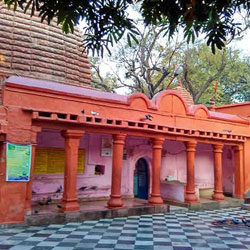
About The Maa Kalyaneshwari Temple The Maa Kalyaneshwari Temple is a revered Hindu temple located in the town of Asansol in Bardhaman, West Bengal. Dedicated to the goddess Kalyaneshwari, an incarnation of Goddess Kali, the temple holds significant religious importance for devotees in the region. The temple attracts a large number of pilgrims and tourists throughout the year who come to seek the blessings of the goddess. Architecture of Maa Kalyaneshwari Temple The Maa Kalyaneshwari Temple is known for its awe-inspiring architecture that showcases a perfect blend of traditional and modern elements. The temple features intricate carvings and sculptures that adorn its walls, depicting various mythological scenes and deities. The main sanctum sanctorum of the temple houses the idol of Maa Kalyaneshwari, adorned with beautiful flowers and ornaments. The temple complex also includes smaller shrines dedicated to other Hindu gods and goddesses, adding to its grandeur. History The history of the Maa Kalyaneshwari Temple dates back several centuries when the region was under the rule of various dynasties. It is believed that the temple was constructed by a devout ruler to honor the goddess and seek her blessings for prosperity and protection. Over the years, the temple has undergone several renovations and additions, making it a prominent religious site in the area. Best Time To Visit The best time to visit the Maa Kalyaneshwari Temple is during the festive season, particularly during Navratri and Diwali, when the temple premises are beautifully decorated and vibrant with celebrations. Additionally, the winter months from October to February are also considered ideal for visiting the temple, as the weather is pleasant and conducive for sightseeing. How To Reach The Maa Kalyaneshwari Temple is easily accessible by road, rail, and air. The nearest airport is Netaji Subhash Chandra Bose International Airport in Kolkata, which is approximately 200 kilometers away from Bardhaman. The temple can also be reached by train, with Asansol Junction being the nearest railway station. For those traveling by road, Bardhaman is well-connected to major cities in West Bengal via a network of highways and roads. Significance Of The Maa Kalyaneshwari Temple The Maa Kalyaneshwari Temple holds immense significance for devotees who believe in the protective and nurturing powers of the goddess. It is believed that seeking the blessings of Maa Kalyaneshwari can bring prosperity, peace, and happiness to one's life. The temple also serves as a place of solace and spiritual refuge for those facing challenges and seeking guidance. The sacred atmosphere of the temple, coupled with the devotion of the worshippers, creates a powerful energy that is palpable to all who visit. Overall, the Maa Kalyaneshwari Temple in Bardhaman is a symbol of faith, devotion, and cultural heritage, drawing people from all walks of life to experience its divine presence and seek blessings for a better future.
Explore More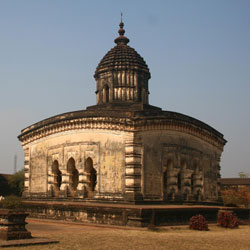
About The Lalji Temple in Bishnupur The Lalji Temple, located in the town of Bishnupur in the Bankura district of West Bengal, is a prominent Hindu temple dedicated to Lord Krishna. The temple is known for its exquisite terracotta artwork, which adorns the walls and facades of the structure. Architecture of Lalji Temple The Lalji Temple showcases the typical terracotta style of architecture that is characteristic of the temples in Bishnupur. The outer walls of the temple are embellished with intricate terracotta panels depicting scenes from Hindu epics such as the Ramayana and Mahabharata. The temple has a single tower with a curved roof, typical of the Bengal style of temple architecture. History The Lalji Temple was built in the 17th century during the reign of the Malla rulers of Bishnupur. The Malla kings were known for their patronage of the arts, and they commissioned the construction of several temples in the region, including the Lalji Temple. The temple stands as a testament to the rich cultural heritage of Bishnupur and the artistic prowess of the craftsmen of that era. Best Time To Visit The best time to visit the Lalji Temple is during the winter months, from November to February, when the weather is pleasant and conducive to exploring the temple complex. The annual Bishnupur Mela, held in December, is also a great time to visit the temple and experience the vibrant cultural festivities of the region. How To Reach The Lalji Temple is easily accessible by road from nearby cities such as Kolkata and Durgapur. Bishnupur is well-connected by a network of buses and taxis, making it convenient for visitors to reach the temple. The nearest railway station is the Bishnupur Railway Station, which is located just a few kilometers away from the temple. Significance Of The Lalji Temple The Lalji Temple holds great religious significance for the devotees of Lord Krishna. The temple is a place of worship and pilgrimage for those seeking the blessings of the deity. The intricate terracotta artwork adorning the temple walls is not just a visual delight but also serves as a medium for depicting the various stories and teachings from Hindu mythology. In conclusion, the Lalji Temple in Bishnupur is a must-visit destination for anyone interested in exploring the rich cultural heritage and artistic legacy of Bengal. The temple's stunning architecture and intricate terracotta artwork make it a unique and mesmerizing sight to behold. Whether you are a history buff, a religious pilgrim, or simply a lover of art and architecture, a visit to the Lalji Temple is sure to leave you enchanted and inspired.
Explore More
About The Kalachand Temple The Kalachand Temple, located in the town of Bishnupur in the state of West Bengal, India, is a famous Hindu temple dedicated to Lord Krishna. It is a significant pilgrimage site for devotees of Lord Krishna and is known for its beautiful architecture and intricate terracotta artwork. Architecture of Kalachand Temple The Kalachand Temple is constructed in the traditional Bengali style of architecture known as the terracotta temple. The temple is built using bricks and laterite stones, with intricate terracotta panels adorning the walls of the temple. These terracotta panels depict scenes from Hindu mythology, including stories from the life of Lord Krishna. The temple complex consists of a sanctum sanctorum where the idol of Lord Krishna is enshrined, surrounded by a covered verandah with pillars and a large courtyard. The temple's unique architecture and exquisite terracotta artwork make it a popular tourist attraction in Bishnupur. History The Kalachand Temple was built in the 17th century by the Malla King Raghunath Singh. The temple was dedicated to Lord Krishna, who is also known as Kalachand. The Malla rulers of Bishnupur were great patrons of art and culture, and they commissioned the construction of several temples in the region, including the Kalachand Temple. Over the centuries, the temple has undergone several renovations and restorations to preserve its architectural beauty and historical significance. Today, the Kalachand Temple stands as a testament to the rich cultural heritage of Bishnupur and attracts visitors from all over the world. Best Time To Visit The best time to visit the Kalachand Temple in Bishnupur is during the winter months from October to February. The weather during this time is pleasant and ideal for exploring the temple complex and its surroundings. The annual Rash Mela festival, which celebrates the divine love of Radha and Krishna, is also held near the temple during this time, making it a popular time to visit. It is important to note that Bishnupur can get quite hot and humid during the summer months, so it is advisable to avoid visiting the temple during this time. The monsoon season, from June to September, can also bring heavy rainfall to the region, making it less than ideal for sightseeing. How To Reach The Kalachand Temple in Bishnupur is easily accessible by road and rail. Bishnupur is well-connected to major cities in West Bengal and other parts of the country by a network of highways and railways. The nearest airport to Bishnupur is in Kolkata, which is approximately 150 kilometers away. Visitors can also take a train to Bishnupur Railway Station, which is located in the town and is well-connected to Kolkata and other major cities. From the railway station, the Kalachand Temple is just a short drive away, and visitors can take a taxi or auto-rickshaw to reach the temple complex. Significance Of The Kalachand Temple The Kalachand Temple holds great religious and cultural significance for devotees of Lord Krishna. The temple is believed to be a sacred place where devotees can offer their prayers and seek the blessings of Lord Krishna. The beautiful terracotta artwork on the walls of the temple also adds to its significance as a work of art and a symbol of the rich cultural heritage of Bishnupur. Many visitors to the Kalachand Temple are also drawn to its serene and peaceful surroundings, making it a popular destination for spiritual seekers and tourists alike. The temple's unique architecture and historical importance make it a must-visit attraction for anyone exploring the town of Bishnupur and its rich cultural heritage.
Explore More
About The Radhashyam Temple in Bishnupur The Radhashyam Temple is a significant religious site located in the town of Bishnupur in the Bankura district of West Bengal, India. It is dedicated to Lord Krishna, who is worshipped here in the form of Radha and Shyam, hence the name Radhashyam Temple. The temple is known for its exquisite architecture and intricate terracotta work, making it a popular tourist destination for art and history enthusiasts. Architecture of Radhashyam Temple The Radhashyam Temple is a prime example of the terracotta temple architecture that Bishnupur is renowned for. The temple stands tall with its ornate carvings and detailed terracotta panels that depict scenes from Hindu mythology, folklore, and everyday life. The temple's pyramid-shaped roof, intricate arches, and intricate terracotta work on the walls are a sight to behold. History The Radhashyam Temple was constructed in the 17th century during the reign of the Malla kings who were patrons of art and culture. The temple was built to commemorate Lord Krishna and his eternal love Radha. Over the centuries, the temple has undergone renovations and restoration work to preserve its architectural beauty and cultural significance. Best Time To Visit The best time to visit the Radhashyam Temple in Bishnupur is during the winter months from November to February when the weather is pleasant and suitable for exploring the town and its historical sites. The annual Bishnupur Festival held in December is also a great time to visit the temple and witness cultural performances and art exhibitions. How To Reach Bishnupur is well-connected by road and rail to major cities like Kolkata and Durgapur. The nearest airport is Netaji Subhas Chandra Bose International Airport in Kolkata, which is approximately 140 kilometers away. Visitors can also take a train to Bishnupur Railway Station, which is well-connected to Kolkata and other parts of the state. Local taxis and auto-rickshaws are available for transportation within the town. Significance Of The Radhashyam Temple The Radhashyam Temple holds immense religious and cultural significance for the people of Bishnupur and devotees of Lord Krishna. The temple is not only a place of worship but also a symbol of the rich artistic heritage of the region. The intricate terracotta work on the temple walls is a testimony to the skilled craftsmanship of the local artisans. Visitors to the temple can experience a sense of peace and spirituality as they admire the beautiful architecture and immerse themselves in the divine aura of the place. In conclusion, the Radhashyam Temple in Bishnupur is a must-visit destination for those interested in history, art, and culture. The temple's architectural beauty, rich history, and religious significance make it a unique and captivating place that leaves a lasting impression on visitors. Experience the charm of the Radhashyam Temple and delve into the cultural tapestry of Bishnupur as you explore this gem of a heritage site.
Explore More
About The Jor Mandir Temples The Jor Mandir Temples are a group of twin temples located in Bishnupur, a town in the Bankura district of West Bengal, India. These temples are dedicated to Lord Krishna and were built during the 17th century by the Malla kings. Architecture of Jor Mandir Temples The Jor Mandir Temples are known for their exquisite terracotta artwork that adorns the walls of the temples. The intricate carvings depict scenes from Hindu epics like the Ramayana and Mahabharata, as well as various aspects of daily life during that period. The temples are built in the traditional Ekaratna style, with a square base and a single tower in the center. History The Jor Mandir Temples were built by the Malla kings who ruled Bishnupur during the 17th century. The temples were constructed as a part of the royal patronage of art and culture in the region. The intricate terracotta artwork on the walls of the temples is a testament to the artistic prowess of the craftsmen of that era. Best Time To Visit The best time to visit the Jor Mandir Temples is during the winter months, from October to February, when the weather is pleasant and ideal for exploring the temples and the surrounding areas. The annual Bishnupur Mela, which takes place in December, is also a great time to visit the temples and experience the local culture and traditions. How To Reach Bishnupur is well-connected by road and rail to major cities like Kolkata and Asansol. The nearest railway station is Bishnupur Railway Station, which is located about 2 kilometers away from the Jor Mandir Temples. The town is also well-served by buses and taxis, making it easy to reach the temples from nearby cities and towns. Significance Of The Jor Mandir Temples The Jor Mandir Temples are not only a religious site but also a cultural and historical treasure. The intricate terracotta artwork on the walls of the temples is a fine example of Bengal's rich artistic heritage. The temples also stand as a symbol of the Malla kings' patronage of art and culture during their rule in Bishnupur. In conclusion, the Jor Mandir Temples in Bishnupur are a must-visit destination for anyone interested in history, art, and culture. The exquisite terracotta artwork, the architectural beauty, and the rich history of these temples make them a unique and captivating place to explore. Whether you are a history buff, an art enthusiast, or a spiritual seeker, the Jor Mandir Temples are sure to leave a lasting impression on you.
Explore More
About St. Theresa Catholic Church, Kalimpong St. Theresa Catholic Church, located in the picturesque town of Kalimpong in the Indian state of West Bengal, is a serene place of worship that attracts locals and tourists alike. The church is dedicated to St. Theresa of Lisieux, also known as the "Little Flower of Jesus," and is a popular destination for those seeking solace and spiritual enlightenment. Location and Visiting Hours The St. Theresa Catholic Church is located in the heart of Kalimpong, near the bustling market area. The church is open to visitors every day from 6:00 AM to 6:00 PM, allowing ample time for worship and meditation. Visitors are encouraged to respect the sanctity of the church and maintain a quiet and respectful demeanor during their visit. History The St. Theresa Catholic Church was established in Kalimpong in the early 20th century by missionaries from Europe. Over the years, the church has become a symbol of faith and community for the local Catholic population, as well as a place of interest for visitors from around the world. Church Services and Events The St. Theresa Catholic Church holds regular mass services throughout the week, with special events and festivals celebrated with great fervor. Mass timings vary, so visitors are encouraged to check the church's schedule for the latest information on services and events. The church is also open on weekends for those looking to attend Sunday mass or simply seek a moment of peace and reflection. Weddings St. Theresa Catholic Church is available for weddings, providing a beautiful and sacred setting for couples looking to exchange their vows in the presence of God. Those interested in holding their wedding at the church are encouraged to contact the church office for more information on availability and requirements. Architectural Facts St. Theresa Catholic Church boasts stunning architectural features, including intricate stained glass windows, towering spires, and ornate decorations that showcase the rich history and heritage of the Catholic faith. The church's elegant design and peaceful ambiance make it a must-visit destination for architecture enthusiasts and spiritual seekers alike. Accessibility and Directions Getting to St. Theresa Catholic Church is easy, whether by car or public transport. The church is conveniently located near the main road, with ample parking available for those driving. For those using public transport, the church can be reached by local buses or taxis, with clear signage directing visitors to the entrance. The church is wheelchair accessible, ensuring that all visitors can experience the beauty and tranquility of this sacred place. Visitor's Information There is no entry fee to visit St. Theresa Catholic Church, making it accessible to all who wish to explore its wonders. Guides are available for those wanting a more in-depth understanding of the church's history and significance. Nearby attractions, such as the bustling market area and scenic viewpoints, offer visitors the opportunity to explore the vibrant culture and natural beauty of Kalimpong. Visitors are advised to dress modestly and respectfully when visiting the church, out of respect for the sacredness of the place.
Explore More
About Macfarlane Memorial Church, Kalimpong Macfarlane Memorial Church in Kalimpong, West Bengal, was built in 1891 in honor of Reverend William Macfarlane. This stunning Scottish Gothic-style church features intricate stonework and stained glass windows. A significant landmark, it reflects Kalimpong’s colonial past and remains an important place of worship and historical interest in the region. Location The Macfarlane Memorial Church is located in the picturesque town of Kalimpong, in the Indian state of West Bengal. Situated in the heart of the town, the church offers stunning views of the surrounding Himalayan mountains. Visiting Hours The church is open to visitors on all days of the week from 9:00 am to 5:00 pm. Visitors are welcome to attend the church services and explore the beautiful architecture of the church. History The Macfarlane Memorial Church was built in 1891 in memory of Reverend William Macfarlane, a Scottish missionary who worked in the region. The church's architecture reflects a blend of Scottish and local influences, making it a unique and historically significant landmark in Kalimpong. Church Services and Events The church holds regular services on Sundays and special events on holidays and festivals. The timings for the services are as follows: - Sunday Service: 10:00 am - Special Events and Festivals: As per the church's schedule Weddings at Macfarlane Memorial Church The church is open for weddings, allowing couples to exchange their vows in the serene and beautiful surroundings of the church. Interested couples can contact the church administration for more information on booking the venue for their special day. Architectural Facts The Macfarlane Memorial Church is known for its striking architecture, featuring a mix of Scottish and local design elements. The church's spire reaches up to the sky, creating a majestic silhouette against the backdrop of the mountains. The stained glass windows and wooden interiors add to the church's charm, making it a must-visit for architecture enthusiasts and history buffs alike. Accessibility and Directions Visitors can reach the Macfarlane Memorial Church by car or public transport. The church is conveniently located in the center of Kalimpong town, making it easily accessible to visitors. Parking facilities are available near the church, allowing visitors to park their vehicles with ease. The church is wheelchair accessible, ensuring that all visitors can explore the church's beauty comfortably. Visitor's Information Entry to the Macfarlane Memorial Church is free of charge, welcoming visitors from all walks of life to explore its historical and architectural significance. Guides are available at the church to provide visitors with insights into the church's history and design. Nearby attractions to visit around the church include Durpin Monastery, Deolo Hill, and Thongsa Gompa. There is no specific dress code for visitors, but it is recommended to dress modestly out of respect for the church's sacred surroundings.
Explore More
About Zang Dhok Palri Phodang, Kalimpong History Zang Dhok Palri Phodang is a Buddhist monastery located in Kalimpong, West Bengal. It was consecrated by His Holiness the Dalai Lama in 1976 and is one of the most important monasteries in the region. The name "Zang Dhok Palri Phodang" translates to "Heavenly Abode of Guru Padmasambhava" in Tibetan. The monastery is built in traditional Tibetan style and is a place of great spiritual significance for Buddhists. Architecture and Design The architecture of Zang Dhok Palri Phodang is a beautiful blend of traditional Tibetan and Bhutanese styles. The main building is adorned with intricate carvings and colorful frescoes depicting Buddhist deities and symbols. The monastery is surrounded by lush greenery and offers stunning views of the Himalayan mountains. The design of the monastery reflects the rich cultural heritage of the Tibetan people and is a sight to behold for visitors. Best Time to Visit The best time to visit Zang Dhok Palri Phodang is during the months of September to December when the weather is pleasant and the skies are clear. This is also the time when the monastery hosts various festivals and events, making it a great opportunity to witness traditional Buddhist rituals and ceremonies. Cultural Significance Zang Dhok Palri Phodang is a place of great cultural significance for Buddhists as it is believed to be the abode of Guru Padmasambhava, a revered figure in Tibetan Buddhism. The monastery is a center for spiritual practice and meditation, drawing pilgrims and visitors from all over the world who seek spiritual enlightenment and inner peace. Pilgrimage Practices Visitors to Zang Dhok Palri Phodang are encouraged to participate in the daily prayers and rituals performed by the monks. Pilgrims can also circumambulate the monastery in a clockwise direction as a form of devotion and purification. It is believed that by engaging in these practices, one can accumulate merit and blessings for oneself and others. Dress Code and Etiquette When visiting Zang Dhok Palri Phodang, it is important to dress modestly and respectfully. Women are advised to wear long skirts or pants and cover their shoulders, while men should wear long pants and shirts with sleeves. Visitors should also remove their shoes before entering the monastery and maintain a respectful silence during prayers and ceremonies. Activities and Experiences Visitors to Zang Dhok Palri Phodang can participate in meditation sessions led by the resident monks, attend teachings on Buddhist philosophy, and explore the beautiful grounds of the monastery. The surrounding area offers opportunities for hiking, birdwatching, and enjoying the serene beauty of the Himalayan landscape. Art and Religious Symbols The monastery is adorned with exquisite Buddhist art and religious symbols, including thangka paintings, statues of Buddhist deities, and intricate mandalas. These artworks serve as objects of devotion and contemplation for practitioners and visitors alike, inspiring a sense of peace and tranquility. Local Insights Local residents of Kalimpong hold Zang Dhok Palri Phodang in high regard and often visit the monastery to seek blessings and guidance from the resident lamas. The monastery plays a central role in the spiritual and cultural life of the community, hosting various events and festivals that bring people together in celebration and prayer.
Explore More8 Night - 9 Days Sikkim Tour Package For - 12 Pax
9 Days/ 8 Night
Gangtok - Darjeeling - Pelling - Yumthang - Lachung - Mangan
4 Night - 5 Days Sikkim Tour Package For - 3 Pax
5 Days/ 4 Night
Gangtok - Darjeeling
5 Nights Darjeeling - Kalimpong Tour
6 Days/ 5 Night
Darjeeling - Kalimpong - Mirik
Darjeeling. 3 Nights 4 Days
4 Days/ 3 Night
Darjeeling
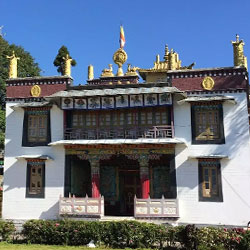
About Tharpa Choling Monastery History, Architecture, and Design Tharpa Choling Monastery, located in Kalimpong, is a historic Buddhist monastery that was founded in 1912 by Domo Geshe Rinpoche Ngawang Kalsang. The monastery is known for its stunning architecture and intricate designs, showcasing traditional Tibetan influences. The main prayer hall is adorned with colorful murals, ancient statues, and ornate carvings, creating a serene and spiritual ambiance for visitors. Best Time to Visit The best time to visit Tharpa Choling Monastery is during the months of March to May and September to November when the weather is pleasant and there are fewer crowds. These months offer clear views of the surrounding mountains and valleys, making it an ideal time for sightseeing and spiritual reflection. Cultural Significance Tharpa Choling Monastery holds significant cultural importance as a center for Buddhist teachings and practices. It is a place where monks and devotees come together to meditate, pray, and engage in religious rituals. The monastery also hosts various cultural events, festivals, and ceremonies throughout the year, showcasing traditional Tibetan customs and beliefs. Pilgrimage Practices Pilgrims from far and wide travel to Tharpa Choling Monastery to pay their respects to the Buddha and seek blessings from the resident monks. Pilgrimage practices often involve circumambulating the main prayer hall, offering prayers and offerings to the deity, and receiving blessings from the monastery's spiritual leaders. These practices are believed to purify the mind and accumulate positive karma. Dress Code and Etiquette Visitors to Tharpa Choling Monastery are expected to dress modestly and respectfully, covering arms and legs to show reverence for the sacred space. It is customary to remove shoes before entering the prayer halls and to maintain a quiet and reverent demeanor while inside. Photography may be restricted in certain areas, so it is important to ask for permission before taking any photos. Activities and Experiences Visitors to Tharpa Choling Monastery can participate in a variety of activities and experiences, including guided tours, meditation sessions, and teachings by resident monks. The monastery also offers opportunities for volunteering, such as helping with maintenance, gardening, or community outreach programs. Visitors can immerse themselves in the monastery's tranquil surroundings and engage in spiritual practices for personal growth and reflection. Art and Religious Symbols Tharpa Choling Monastery is adorned with beautiful artworks and religious symbols that hold deep spiritual significance for Buddhist practitioners. The monastery's architecture incorporates intricate mandalas, thangkas, and statues of Buddhas, bodhisattvas, and other deities, each representing different aspects of enlightenment and compassion. These artistic expressions serve as visual aids for meditation and contemplation, inspiring devotion and inner transformation. Local Insights Visitors to Tharpa Choling Monastery can gain valuable insights into Tibetan culture, history, and spiritual traditions by interacting with the resident monks and local community members. The monastery serves as a hub for preserving and promoting Tibetan Buddhist teachings, as well as fostering cultural exchange and understanding among visitors from diverse backgrounds. By engaging with the local community, visitors can deepen their appreciation for the rich heritage and living traditions of the Himalayan region.
Explore More
About The ISKCON Temple Siliguri The ISKCON Temple in Siliguri, also known as Sri Sri Radha Madhav Sundar Mandir, is a spiritual haven for devotees and tourists alike. It is a part of the International Society for Krishna Consciousness (ISKCON) founded by A. C. Bhaktivedanta Swami Prabhupada in 1966. The temple complex is spread across a vast area and is dedicated to Lord Krishna and Radha. It serves as a hub for spiritual activities, cultural programs, and social welfare initiatives. Architecture of ISKCON Temple Siliguri The architecture of the ISKCON Temple in Siliguri is a beautiful blend of traditional Indian temple design and modern aesthetics. The temple's main structure is adorned with intricate carvings and colorful motifs that depict various scenes from Hindu mythology. The main altar houses the deities of Lord Krishna and Radha, along with other important figures in the Hare Krishna movement. The temple also features a spacious prayer hall, a meditation room, and a serene garden for devotees to relax and meditate. History The ISKCON Temple in Siliguri was established in the early 1990s by a group of dedicated followers of A. C. Bhaktivedanta Swami Prabhupada. Over the years, the temple has grown in popularity and has become a prominent spiritual destination in the region. The temple has played a significant role in spreading the teachings of Lord Krishna and promoting a lifestyle based on spiritual principles and devotion. Best Time To Visit The best time to visit the ISKCON Temple in Siliguri is during the major festivals such as Janmashtami (Lord Krishna's birthday) and Radhastami (Radha's appearance day). These festivals are celebrated with great pomp and show, and devotees from all over the country come to participate in the festivities. The temple is beautifully decorated during these times, and the atmosphere is filled with joy and devotion. How To Reach The ISKCON Temple in Siliguri is located in the heart of the city and is easily accessible by road. The temple is well-connected to the main bus stand and railway station, making it convenient for devotees and tourists to visit. Siliguri is well-connected to major cities in India by air, rail, and road, making it easy for travelers to reach the temple from different parts of the country. Significance Of The ISKCON Temple Siliguri The ISKCON Temple in Siliguri holds great significance for the followers of the Hare Krishna movement and for spiritual seekers in general. The temple serves as a center for spiritual enlightenment, cultural enrichment, and social welfare activities. It offers various programs such as bhajans, kirtans, discourses, and yoga classes to help individuals connect with their inner selves and cultivate a deeper understanding of life and spirituality. The temple also runs charitable programs to help the underprivileged and promote a sense of community service among its members. Overall, the ISKCON Temple in Siliguri is a place of peace, harmony, and devotion where visitors can experience a sense of spiritual upliftment and connect with the divine presence of Lord Krishna and Radha.
Explore More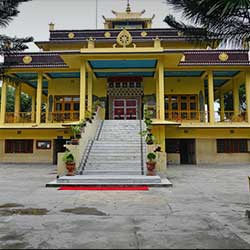
About Salugara Monastery History Located in Siliguri, West Bengal, the Salugara Monastery was established in 1960 by Tibetan monks fleeing Chinese oppression. The monastery serves as a spiritual refuge for Buddhist followers and has since become a popular pilgrimage site for both locals and tourists alike. Architecture and Design The Salugara Monastery is characterized by traditional Tibetan architecture, with vibrant colors and intricate designs adorning its exterior. The main prayer hall is adorned with statues of revered deities and intricate thangka paintings, creating a serene and meditative atmosphere for worshippers. Best Time to Visit The best time to visit the Salugara Monastery is during the annual Tibetan New Year celebrations, known as Losar, which usually falls in February or March. During this time, the monastery is adorned with colorful prayer flags and locals come together to participate in traditional ceremonies and rituals. Cultural Significance The Salugara Monastery holds immense cultural significance for the Tibetan community in exile, serving as a symbol of resilience and spiritual strength in the face of adversity. Visitors can experience the rich Tibetan culture through traditional ceremonies, chants, and rituals performed at the monastery. Pilgrimage Practices Pilgrims visiting the Salugara Monastery often engage in prostrations, circumambulations, and offering of prayers and butter lamps as part of their spiritual practice. These practices are believed to purify the mind and create positive energy, fostering a sense of inner peace and spiritual connection. Dress Code and Etiquette Visitors to the Salugara Monastery are expected to dress modestly and respectfully, covering their shoulders and knees when entering the premises. It is also customary to remove shoes before entering the prayer hall and to refrain from loud talking or disruptive behavior out of respect for the monks and worshippers. Activities and Experiences Visitors to the Salugara Monastery can participate in meditation sessions, attend teachings and workshops on Buddhist philosophy, and explore the surrounding gardens and stupas. The monastery also hosts cultural events, such as traditional dance performances and art exhibitions, providing a well-rounded spiritual and cultural experience. Art and Religious Symbols The Salugara Monastery is adorned with intricate murals, statues, and thangka paintings depicting various Buddhist deities, symbols, and teachings. These artistic representations serve as visual aids for meditation and contemplation, offering worshippers a deeper connection to the spiritual world. Local Insights Local residents of Siliguri often visit the Salugara Monastery to seek blessings, participate in prayers, and offer donations to support the monks and their community. Many locals also volunteer at the monastery, helping with maintenance, gardening, and organizing events to preserve and promote Tibetan culture and spirituality.
Explore More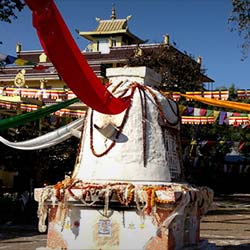
About Sed-Gyued Monastery Sed-Gyued Monastery, located in Siliguri, is a prominent Tibetan Buddhist monastery known for its serene ambiance and spiritual significance. Established in the early 20th century, the monastery attracts visitors with its rich history, intricate architecture, and profound cultural heritage. History, Architecture and Design The Sed-Gyued Monastery was founded by the Tibetan Buddhist community in exile, seeking refuge in India. The monastery's architecture reflects traditional Tibetan designs, with colorful murals, intricate woodwork, and ornate statues adorning the prayer halls. The main shrine of the monastery houses a sacred statue of Buddha, surrounded by prayer wheels and butter lamps. Best Time to Visit The best time to visit the Sed-Gyued Monastery is during the Tibetan New Year celebrations, known as Losar, which usually falls in February or March. This festive period offers a glimpse into Tibetan culture and traditions, with colorful rituals, masked dances, and traditional music performances. Cultural Significance The Sed-Gyued Monastery holds immense cultural significance as a center for Tibetan Buddhism in India. It serves as a place of worship, meditation, and education for the Tibetan community, preserving their spiritual heritage and teachings for future generations. Pilgrimage Practices Pilgrims visiting the Sed-Gyued Monastery often participate in prayer ceremonies, prostration rituals, and meditation sessions to deepen their spiritual connection. The monastery's peaceful surroundings and spiritual aura create a conducive environment for self-reflection and introspection. Dress Code and Etiquette Visitors to the Sed-Gyued Monastery are advised to dress modestly and respectfully, covering shoulders and knees. Removing shoes before entering prayer halls and refraining from loud noises or disruptive behavior are common etiquette practices observed at the monastery. Activities and Experiences Visitors to the Sed-Gyued Monastery can engage in a variety of activities and experiences, including attending teachings by resident monks, participating in guided meditation sessions, exploring the monastery's art and artifacts, and interacting with the local community to gain insights into Tibetan culture. Art and Religious Symbols The Sed-Gyued Monastery is adorned with intricate artwork depicting Buddhist deities, mandalas, and religious symbols that carry deep spiritual meanings. The colorful thangka paintings, intricate thrones, and elaborate rituals reflect the monastery's devotion to preserving and propagating Tibetan Buddhist art and iconography. Local Insights Interacting with the local Tibetan community and monks at the Sed-Gyued Monastery offers visitors valuable insights into their daily practices, beliefs, and cultural traditions. Engaging in conversations, participating in community events, and supporting local artisans and businesses are ways to appreciate and contribute to the vibrant Tibetan culture in Siliguri.
Explore More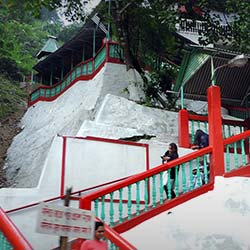
About The Sevoke Kali Mandir Temple The Sevoke Kali Mandir Temple is a renowned Hindu temple located in Sevoke, a small town near Siliguri in the state of West Bengal, India. Dedicated to the goddess Kali, this sacred place of worship attracts devotees and tourists alike with its peaceful ambiance and stunning architecture. Architecture of Sevoke Kali Mandir Temple The Sevoke Kali Mandir Temple is a fine example of traditional Bengali temple architecture. The temple is built in the traditional "nava-ratna" style, featuring nine spires that symbolize the nine forms of Goddess Durga. The intricate carvings on the walls and pillars, along with the vibrant colors used in the decorations, add to the temple's grandeur. The main sanctum sanctorum houses a beautiful idol of Goddess Kali, adorned with flowers and jewelry. History The Sevoke Kali Mandir Temple has a rich historical significance, dating back to the early 18th century. It is said that the temple was established by a saint who had a vision of Goddess Kali directing him to build a temple at the spot where the idol was found. Over the years, the temple has undergone several renovations and improvements, but its spiritual essence has remained unchanged. Best Time To Visit The best time to visit the Sevoke Kali Mandir Temple is during the festive season, especially during Navratri and Diwali when the temple is adorned with lights, flowers, and decorations. The atmosphere during these times is vibrant and festive, with devotees flocking to the temple to seek blessings from the goddess. How To Reach The Sevoke Kali Mandir Temple is easily accessible by road from Siliguri, which is well-connected to major cities in India. Visitors can hire a taxi or take a local bus to reach the temple, which is located just a few kilometers away from the main town. The nearest airport is Bagdogra Airport, which is located about 20 kilometers away from the temple. Significance Of The Sevoke Kali Mandir Temple The Sevoke Kali Mandir Temple holds immense significance for the devotees who believe that worshipping the goddess brings protection, prosperity, and well-being. Many devotees also visit the temple to seek guidance and blessings from Goddess Kali during challenging times in their lives. The serene surroundings of the temple provide a peaceful retreat for those looking to connect with their spiritual side and find solace in the divine presence of the goddess.
Explore More
Gangasagar is a village and a gram panchayat within the jurisdiction of the Sagar police station in the Sagar CD block in the Kakdwip subdivision of the South 24 Parganas district in the Indian state of West Bengal.
Explore More